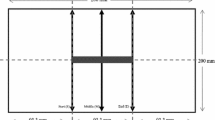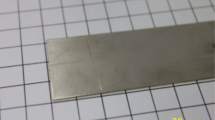Abstract
The aim of this work is to propose an experimental method to evaluate the steel carbon content by ultrasound. The sample is immersed in a water tank in order to analyze it under various incidences of sound waves. Longitudinal wave velocities are measured by immersion by using a 5-MHz frequency probe. Transverse wave velocities are measured in a contact mode by using a 4-MHz transverse wave transducer. The attenuation coefficients of ultrasonic longitudinal and transverse waves are deduced from three successive basic echoes through the sample. The effects of some heat treatments on ultrasonic parameters are also studied. The measurement of ultrasonic parameters in steel offers an interesting possibility of tracing the carbon content and, at the same time, provides information on the steel structure and its elasticity.
Similar content being viewed by others
References
A. Badidi Bouda, A. Benchaala, and K. Alem, “Ultrasonic Characterization of Materials Hardness,” Ultrasonics 38, 224–227 (2000).
J. Rivenez and A. Lambert, “Mesure et Appréciation non Destructives des Gradients de Dureté,” CETIM Inform, No. 97 (1986).
V. L. de Araujo Freitas, V. H. C. de Albuquerque, and S. E. de Macedo, “Nondestructive Characterization of Microstructures and Determination of Elastic Properties in Plain Carbon Steel Using UltrasonicMeasurements,” Mater. Sci. Eng. A 527(16/17), 4431–4437 (2010).
Steel Castings Handbook, Suppl. 8: High Alloy Data Sheets. Corrosion Ser. (Steel Founders’ Soc. Amer., 2004).
M. Durand-Charre, La Microstructure des Aciers et des Fontes: Genèse et Interprétation (SIRPE, Paris, 2003).
A. Badidi Bouda, S. Lebaili, and A. Benchaala, “Grain Size Influence on Ultrasonic Velocities and Attenuation,” NDTE Int. 36(1), 1–5 (2003).
C. Gracier and B. Horsten, “Simultaneous Measurement of Speed, Attenuation, Thickness and Density with Reflected Ultrasonic Waves in Plates,” IEEE. Ultrasonic Symp. 1219–1222 (1994).
F. Peters and L. Petit, “A Broad Band Spectroscopy Method for Ultrasound Wave Velocity and Attenuation Measurement in Dispersive Media,” Ultrasonics 41, 357–363 (2003).
S. Hireskorn, P. W. Van Andel, and U. Netzelmann, “Ultrasonic Methods to Detect and Evaluate Damage in Steels,” Nondestruct. Test. Evaluat. 15, 365–373 (2000).
Research Techniques in Nondestructive Testing, Ed. by R. S. Sharpe (Academic Press, London, 1980), Vol. 4.
J. Saniie, T. Wang, and N. M. Bilgutay, “Analysis of Homomorphic Processing for Ultrasonic Grain Signal Characterization,” IEEE Trans. UFFC 36(3), 365–375 (1989).
L. G. Merkulov, “Investigation of Ultrasonic Scattering in Metals,” Soviet Phys. Tech. Phys. 1, 59–69 (1957).
Author information
Authors and Affiliations
Corresponding author
Additional information
Original Russian Text © A. Badidi Bouda, H. Belkhelfa, W. Djerir, R. Halimi.
__________
Translated from Prikladnaya Mekhanika i Tekhnicheskaya Fizika, Vol. 55, No. 3, pp. 174–180, May–June, 2014.
Rights and permissions
About this article
Cite this article
Badidi Bouda, A., Belkhelfa, H., Djerir, W. et al. Nondestructive evaluation of the carbon content in steel. J Appl Mech Tech Phy 55, 524–529 (2014). https://doi.org/10.1134/S0021894414030158
Received:
Published:
Issue Date:
DOI: https://doi.org/10.1134/S0021894414030158




